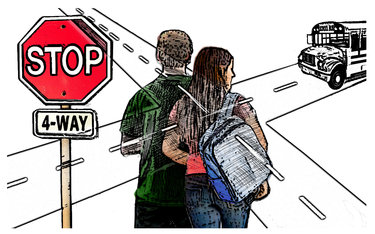Every news story has a story of its own
The anatomy of a news story is worth examining. Here’s how a recent one unfolded.
On Tuesday, Jan. 23, our Guilderland reporter, Elizabeth Floyd Mair, learned that early that morning there had been a hit-and-run accident at the intersection of School Road and Route 146 in Guilderland Center.
She put aside work on some other planned stories to find out what she could about the accident. There was no press release.
Floyd Mair called Curtis Cox, deputy chief for the Guilderland Police who serves as the department’s spokesman, and he got back to her the next day with as much as he knew:
The call came in at 6:58 a.m. from someone in the district’s nearby garage. “I don’t know if a school-bus driver saw it and radioed the garage,” Cox said and we quoted him on that in our article.
The vehicle had pulled out from the direction of Park Guilderland Apartments, across Route 146 from School Road, which leads to the high school. The intersection is less than half a mile from the school, which starts at 7:30 a.m.
Cox surmised the student was a male, because a narrative about the accident included the phrase, “Says he’s hurt.”
We recalled an accident we had covered years ago, in 1999, where a high school student, hit by a student driver at that same intersection had suffered brain injury. We vividly remembered the speech Matthew Hannon had made two years later as class president at his high school graduation. He had just recently learned how to walk again, and he walked and spoke haltingly.
His principal had told us he was literally dead on the scene. “Through sheer strength of will, he fought his way back,” the principal said. “He went through extensive rehabilitation. It just shows what determination can do.”
We knew then this wasn’t just a simple accident story but rather might be about a larger problem, an underlying cause.
Floyd Mair, showing determination of her own, drove to the site of the accident, taking both video and still shots. In talking to the mother of another student who has to traverse that intersection to get to and from school every day, she learned that often pedestrians have to wait through several light cycles to cross. She verified this by watching and talking to pedestrians at the intersection.
Floyd Mair also talked to a spokesman for the state’s Department of Transportation, Bryan Viggiani. “Vehicles making a turn should always slow down and check for pedestrians or bicyclists, period,” Viggiani said. He said this is true even when a driver has a solid green traffic light and is all the more true when the pedestrian signal is activated.
With the Jan. 25 story, we ran a four-column colored picture of a student waiting to cross Route 146. She had pushed the pedestrian crossing button and the signal showed she had six seconds left to cross. The picture also showed the light was green and a school bus was turning from School Road into the crosswalk.
After the story ran, we received a letter to the editor from the president and vice president of the executive board of the Guilderland Central School District Employees’ Association, which we printed in our next edition, on Feb. 1. We’re always pleased to run letters like this that bring varied viewpoints to our pages, often helping the community to move forward.
The letter made two main points. First, that The Enterprise should have credited the bus driver who saw the hit-and-run accident, radioed it in so the student could be helped, and gave police the plate number of the driver who left the scene.
Quite simply, we couldn’t report on this earlier because we didn’t know it. Reporters are not omniscient. We have to discover the truth in order to print it. We wrote as much as we knew from what Cox had told us. We then asked the letter writer for the name of the bus driver so we could interview him or her but he declined.
We’re fond of a quote from Walter Lippmann: “The theory of the free press is not that the truth will be presented completely or perfectly in any one instance, but that the truth will emerge from free discussion.”
And that is precisely what happened in this evolving story. By the time we published on Feb. 1, we were able to get a hold of the arrest report, detailing how the accident happened as well as an explanation from the driver’s point of view.
The second main point made by the union letter-writers was that our picture had insinuated that the bus drivers were at fault for turning into the crosswalk while the pedestrian crossing signal was activated and a student waited to cross. The letter writers pointed out that the student in the photo is not standing in or directly next to the crosswalk. This is true. She was not.
But a sign on the edge of the picture said to yield to pedestrians. And, as the school superintendent, Marie Wiles, pointed out in our Feb. 1 story, the district’s transportation supervisor had reminded all of the district’s bus drivers that it is their responsibility, if it looks like someone is poised to enter a crosswalk, to try very hard to make eye contact, to see if the person is trying to cross.
The big news in our Feb. 1 story, though, was that the DOT had moved immediately to improve the situation. Guilderland Police Chief Carol Lawlor had instructed her officers to monitor the intersection and to reach out to the DOT to see what changes might improve safety.
Our Feb. 1 story ran with a picture of a huge lit-up sign placed at the intersection, saying “Yield To Pedestrians.” Most importantly, the signal at the crosswalk that goes across Route 146 was changed to stop traffic in all directions for seven seconds to allow pedestrians enough time to get well into the crosswalk where drivers must yield to them.
This solves the problem that the picture the week before had depicted — a walker standing back from the intersection, to stay safe, while the time counts down and traffic flows on.
But this story is not yet finished. We’ve gotten a slew of responses on our Facebook page and by phone from readers who say the problem is only partly solved. There’s a gray area, which we termed a “crosswalk conundrum,” because the state’s Vehicle and Traffic Law says pedestrians must actually be in a crosswalk for cars to be obligated to stop.
At the same time, the school superintendent, Dr. Wiles, correctly pointed out, “I don’t think we want to see people standing in the road.”
One suggestion we’ve heard is to make the seven-second delay function in both directions.
Another recommendation is to have school buses, which observers say have the room, pick up students from Guilderland Center.
A third recommendation is to cut back on the traffic before school starts and after school gets out by limiting parental drop-offs and pick-ups, requiring students to ride the provided buses instead.
Yet another suggestion is to define an alternate route to the school.
We urge school leaders to meet with police, community members, and DOT representatives to work out a solution.
We are honored to have played a role in helping to solve an important problem. It’s worth the effort if it prevents one more student from being hurt. We commend the DOT, the police, the bus drivers, and the superintendent for answering our questions and working together to seek a solution that works for everyone. We hope the momentum continues.
We’ll stay on the story so our community is informed.


